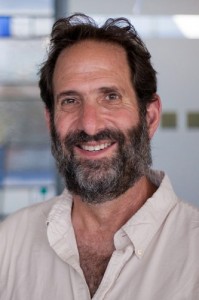
Professor Steve Yalisove of the University of Michigan
Do you know what the difference is between a material’s strength and its toughness? If you’re like most of us, you don’t. But that difference plays a big part in why springs don’t snap under pressure and why only certain materials can be used for the frames in buildings and bridges.
Listen in and get the scoop on material toughness and strength as we host our first interviewee, Professor Steve Yalisove of the University of Michigan’s Material Science and Engineering department, where he teaches an introductory material science course.
Mailbag
-
Peter from Calgary writes:
I just listened to the episode on speciation – thanks for the shout out – and I have a beef with one of the items you discussed. There was mention in there of humans evolving larger thumbs because of computers or losing their pinkies, etc. This was taken as proof that “we’re still evolving”.
Now, maybe I’m off-base here, but although mutations happen all the time they only become dominant if there’s some evolutionary advantage. If someone with a longer thumb was more successful (i.e. more likely to reproduce) then over time the thumb would grow. The same goes for any feature. Humanity will not lose its pinky unless:
- People with stubby pinkies are sexy and make lotsa babies
- People with long pinkies are gross and rather than mating will spend their time in the basement alone playing WOW
- People with stubby pinkies are more likely to live to reproductive age, as longer pinkies are fatal
The above example may be a bit extreme, but it illustrates that in an age of “there’s a match for everyone” and “science should be able to cure all (or at least give anyone with any condition or deformity a normal life” we have removed the evolutionary pressures from our society.
Come to think of it, the evolution of man (past, present and future) could prove to be a very interesting show on its own.
Keep up the good work!
Peter
PS: Orad, unless you were hosting this podcast from the bottom of a rain barrel, it’s definitely time for a new mic.
This episode was researched, written, hosted and recorded by Orad Reshef, Jesse Corbeil and Steve Yalisove. Sound editing was done by Jesse Corbeil, Orad Reshef and Aimee Gillespie.

Peter raised some interesting issues in his mailbag entry about evolution. Specifically, he discussed the conditions under which humanity would lose the pinky finger, noting that if short pinkies gave us a reproductive advantage or if long pinkies gave us a reproductive disadvantage, then the finger would likely go the way of the Do Do.
That’s true, but let’s think about this issue in other terms: growing a pinky takes energy, and organisms only have so much energy to throw around. So another way to frame the problem is to ask: if we didn’t spend energy growing pinky fingers, where else would we spend that energy, and would that tradeoff be reproductively advantageous? Answering that question would tell us whether we should start investing in new gloves or stick to the current 5-finger models.
As Peter points out, there are both biological and sociological factors in figuring out this question. (Another interesting issue here is the relation between nature and nurture, which is too intricate to get into here, but definitely worth exploring!) However, I disagree that science has removed evolutionary pressures from our society. Certainly modern medicine has come a long way in overcoming certain evolutionary pressures, but we still feel those pressures through (a) diseases for which we don’t yet have a cure, and (b) cures that are beyond the financial capacity of certain individuals/groups.
Our evolutionary pressures have changed dramatically as a result of human societal developments, but I think that it’s overstating the case to say that evolutionary pressures have been removed: we’ve made the human being tougher (in the technical sense that it takes more energy to make us break), but not invulnerable.